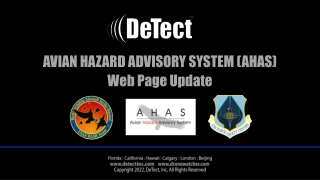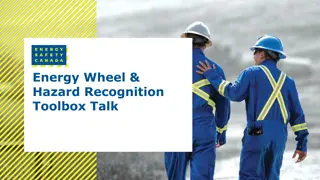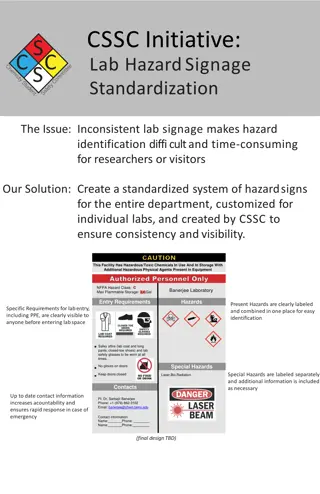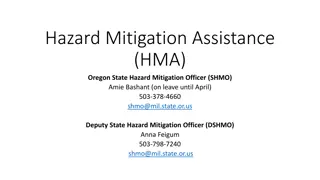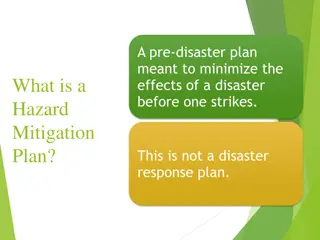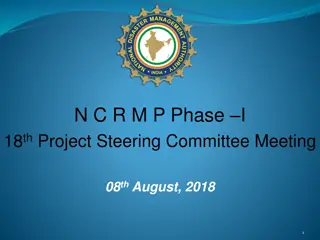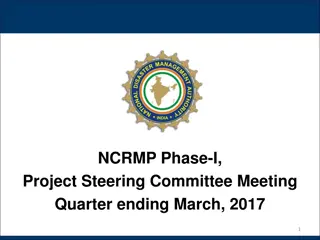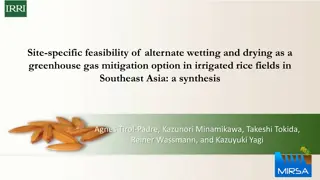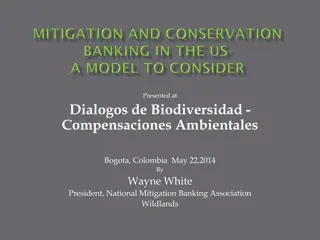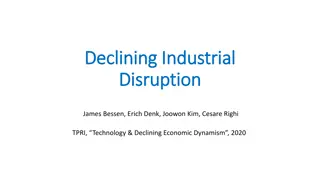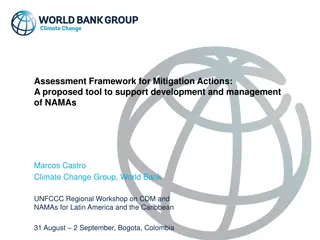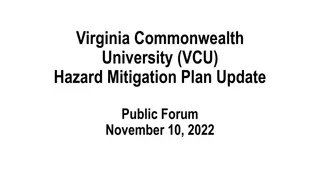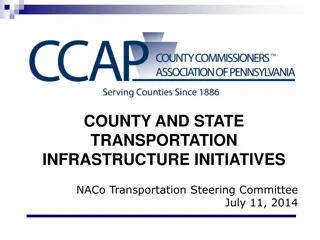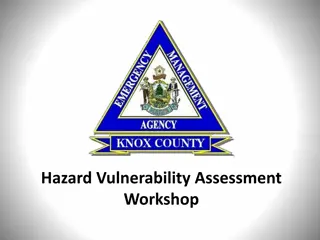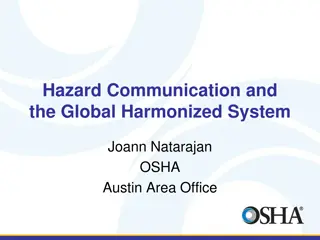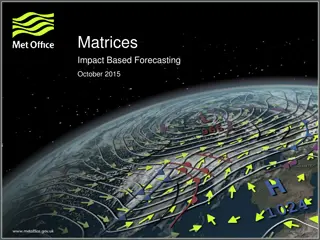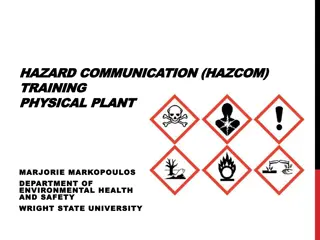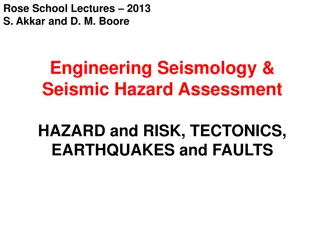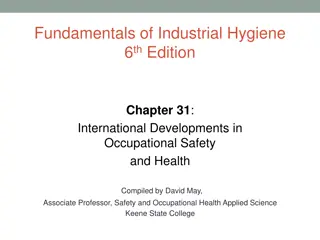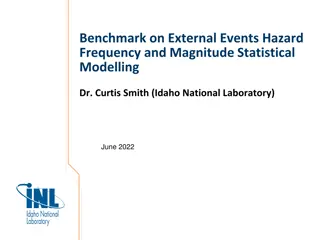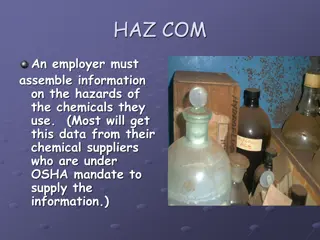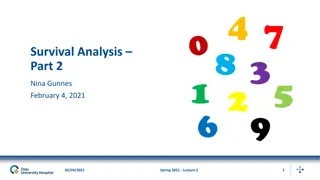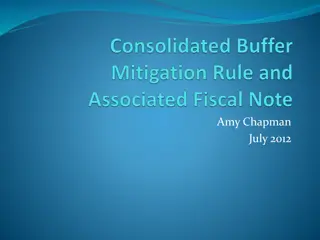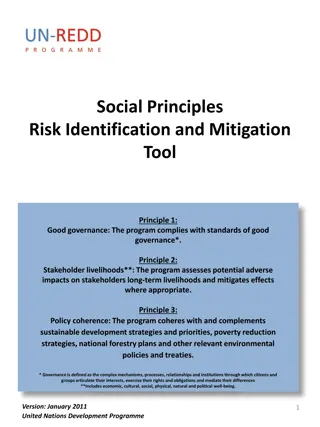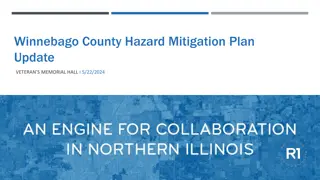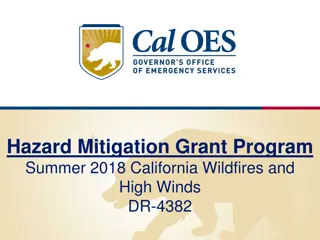Avian Hazard Advisory System (AHAS) Update
The latest updates to the Avian Hazard Advisory System (AHAS) providing crucial bird hazard information for flight safety. Learn about calculating NEXRAD risk, regional mosaics, flying areas, and risk management.
0 views • 23 slides
Workshop on Tracking Progress of the Mitigation Commitments of Nationally Determined Contributions
Workshop on Tracking Progress of the Mitigation Commitments of Nationally Determined Contributions will focus on enhancing transparency frameworks, modalities, procedures, and guidelines related to NDC tracking provisions. It includes detailed information on mitigation policies, actions, and plans o
1 views • 11 slides
Energy Wheel & Hazard Recognition Toolbox Talk
Hazard recognition is crucial for safety in all activities. Hazards can range from gravity and motion to mechanical and chemical risks. Failure to identify hazards can lead to incidents, making tools like the Energy Wheel key for improving recognition. The Energy Wheel enhances hazard recognition by
2 views • 10 slides
Virginia Commonwealth University Hazard Mitigation Plan Update
The Virginia Commonwealth University (VCU) Hazard Mitigation Plan (HMP) Update Public Comment Meeting #1 took place on April 5, 2022. The meeting included introductions, overview of hazard mitigation planning, work plan details, data and information needs, next steps, and action items. Various commi
0 views • 20 slides
Standardized Hazard Signage for Lab Safety
Addressing the challenge of inconsistent lab signage hindering hazard identification, our solution introduces a standardized system for hazard signs within the department. By customizing signage for individual labs and ensuring consistency and visibility, researchers and visitors can easily identify
0 views • 8 slides
Understanding Hazard Curves in Dam Safety Risk Assessments
This content focuses on the role of hazard curves in dam safety risk assessments, emphasizing the level of effort required for their development and the use of HEC software. It highlights the three components of risk (hazard, performance, consequence), discusses hazardous loads and potential consequ
1 views • 58 slides
Comprehensive Risk Assessment and Hazard Mitigation Planning
This work delves into risk assessment and hazard mitigation planning supported by the National Science Foundation. It covers the importance of hazard identification, risk assessment, and mitigation planning components. Mitigation actions are outlined to reduce risks to life and property, prevent dam
2 views • 20 slides
Mitigation of DMA-based Rowhammer Attacks on ARM
Practical strategies are presented in "GuardION: Practical Mitigation of DMA-based Rowhammer Attacks on ARM" to defend against Rowhammer attacks on ARM architecture. The paper discusses Rowhammer defenses, RAMPAGE attacks on Android OS, and introduces GuardION as a lightweight mitigation approach. I
0 views • 48 slides
Hazard Mitigation Assistance (HMA) Funding Eligibility and Priority
Entities within the declared disaster area have priority to apply for Hazard Mitigation Assistance (HMA) funding. Eligible applicants include those in Clackamas, Coos, Douglas, Jackson, Jefferson, Josephine, Klamath, Lake, Lane, Lincoln, Linn, Marion, Tillamook, Wasco, Washington, Yamhill Counties,
0 views • 21 slides
Understanding Wildfire Risk Mitigation Among Private Landowners
Activities involving fuel reduction and defensible space are crucial among private landowners for mitigating wildfire risks. Factors influencing mitigation behavior include wildfire hazard, past experiences, perceived risk, and social context. Information from local government agencies and fire awar
3 views • 15 slides
Importance of Hazard Mitigation Plans for Scott County
Hazard Mitigation Plans are crucial for Scott County as they allow the county and participating jurisdictions to qualify for FEMA grant funding by minimizing disaster effects before they occur. Scott County has a current plan approved by FEMA, adopted in 2017, and set to expire in November 2022. The
0 views • 26 slides
Lake Brenton Disaster Mitigation Plan Overview
The Lake Brenton Residents Association plays a crucial role in disaster response with defined responsibilities including being the first responder, securing the area, and coordinating with authorities. The Disaster Mitigation Plan for Lake Brenton outlines roles, organizational structure, procedures
1 views • 20 slides
National Cyclone Risk Mitigation Project Phase I Summary
The National Cyclone Risk Mitigation Project (NCRMP) aims to reduce cyclone risk and vulnerability in coastal areas by developing an Early Warning Dissemination System, constructing cyclone risk mitigation infrastructure, and building capacity in coastal communities. Phase I in Andhra Pradesh and Od
0 views • 31 slides
National Cyclone Risk Mitigation Project Update
The National Cyclone Risk Mitigation Project aims to reduce cyclone risks and build resilience in coastal areas through components like Early Warning Dissemination System and Cyclone Risk Mitigation Infrastructure. This update covers progress on awarding contracts, site identification, equipment pro
0 views • 30 slides
Feasibility of Alternate Wetting and Drying as a GHG Mitigation Option in Rice Fields
This synthesis study explores the site-specific feasibility of alternate wetting and drying (AWD) as a greenhouse gas mitigation option in irrigated rice fields in Southeast Asia. The research analyzes the impact of environmental and soil properties on GHG mitigation, evaluates trade-offs and co-ben
1 views • 19 slides
Mitigation and Conservation Banks: A Comprehensive Overview
This content presents insights from Wayne White, President of the National Mitigation Banking Association, regarding the concept of mitigation/conservation banks, their evolution, benefits, agency requirements, and the principles behind their establishment. It emphasizes the importance of market-dri
0 views • 28 slides
Probabilistic Tsunami Hazard Assessment Project for the NEAM Region
The project, coordinated by Istituto Nazionale di Geofisica e Vulcanologia (INGV) with various partners, aims to develop a region-wide Probabilistic Tsunami Hazard Assessment (PTHA) for the North East Atlantic and Mediterranean coastlines. It involves creating PTHA database and maps, engaging intern
0 views • 10 slides
Enhancing Safety through Systematic Hazard Combinations Analysis in NPP Design Basis & PSA at NPP Paks
In this preparatory study, Tamas Siklossy, Attila Bareith, and Barnabas Toth discuss the importance of considering hazard combinations in the design basis and PSA of the Paks NPP in Hungary. The study reviews current practices, outlines technical tasks, and emphasizes the need to assess the impact o
0 views • 17 slides
Conceptual Design and Risk Assessment of Forced Safety Injection for Station Blackout Accident Mitigation
This study focuses on the application of Forced Safety Injection Tanks (FSITs) for mitigating accidents like Station Blackout (SBO) in nuclear plants. The research analyzes the need for FSITs, compares FSITs with other safety systems, and discusses the operational strategies for FSITs to prevent cor
1 views • 17 slides
Declining Competition and Industrial Disruption Study
Research conducted by James Bessen, Erich Denk, Joowon Kim, and Cesare Righi focuses on the trends in competition and industrial disruption, with a specific emphasis on the hazard of displacing top firms, impacts of investments by dominant firms, and the relationship between displacement hazard, mar
0 views • 38 slides
Panopticon: Complete In-DRAM Rowhammer Mitigation
Despite extensive research, DRAM remains vulnerable to Rowhammer attacks. The Panopticon project proposes a novel in-DRAM mitigation technique using counter mats within DRAM devices. This approach does not require costly changes at multiple layers and leverages existing DRAM logic for efficient miti
0 views • 17 slides
Assessment Framework for Mitigation Actions: A Tool for NAMA Development
This proposed tool supports the development and management of Nationally Appropriate Mitigation Actions (NAMAs) by providing a structured approach to assess and prioritize different mitigation programs. The tool is designed to assist developing countries, donor countries, and private investors in ev
0 views • 20 slides
Virginia Commonwealth University (VCU) Hazard Mitigation Plan Update Public Forum
Virginia Commonwealth University (VCU) is updating its Hazard Mitigation Plan to address natural, human-caused, and technological threats affecting the campus. The plan aims to lessen disaster impact, assess vulnerabilities, develop mitigation strategies, and prioritize high-risk areas. VCU's rich h
0 views • 40 slides
Transportation Infrastructure Initiatives in Dauphin County
The County and State Transportation Infrastructure Initiatives in Dauphin County include the PennDOT Bridge Bundling Program, Dauphin County Infrastructure Bank, PennDOT Agility Program, and Next Generation Transit Revitalization Investment Districts. The Bridge Bundling Program aims to save time an
0 views • 26 slides
Comprehensive Hazard Vulnerability Assessment Workshop and Tools
In this collection of images and descriptions, various aspects of Hazard Vulnerability Assessment (HVA) workshops, tools, and scoring methods are covered. Topics include risk assessment, planning policies, human factors, probability considerations, environmental and non-environmental hazard scoring,
0 views • 21 slides
Understanding Hazard Communication and the Global Harmonized System
This content discusses the changes introduced by the Global Harmonized System in Hazard Communication Standards (HCS). It highlights the impact on classifications, labels, safety data sheets, and information and training requirements. The GHS aims to enhance workplace safety by providing a standardi
0 views • 37 slides
Combining Natural Hazards with Societal Issues: Unit 1 Hazard Map Template
Delve into Unit 1 of the Hazard Map Template, identifying and locating regions susceptible to hazards by choosing top hazards in the mapping area. Create hazard maps, combine shapes, and include a key and sources for a comprehensive view of potential hazards and vulnerabilities.
0 views • 13 slides
Understanding Hazard Matrices and Impact-Based Forecasting
Hazard matrices are essential tools for coordinating emergency preparedness and response by categorizing primary, secondary, and tertiary effects of hazards. Impact matrices help organizations assess risks and determine potential impacts of events, allowing for better planning and mitigation strateg
0 views • 12 slides
Risk Assessment and Hazard Mitigation Overview
This document introduces risk assessment and hazard mitigation planning, supported by the National Science Foundation. It outlines the key components of risk assessment and hazard mitigation planning, emphasizing the importance of identifying and addressing the greatest risks. The process includes h
0 views • 20 slides
Importance of Hazard Communication Training for Workplace Safety
Hazard communication training is essential for creating a safe work environment by helping individuals recognize and manage hazardous materials effectively. Understanding the Globally Harmonized System (GHS) and following hazard communication laws can improve workplace safety, protect human health,
0 views • 36 slides
Hazard Communication Training and Safety Data Sheets Overview
This resource provides detailed information on hazard communication training, safety data sheets (SDS), GHS format elements, HMIS and NFPA labeling systems, GHS symbols, and building safety precautions. It covers essential aspects such as hazard identification, SDS requirements, chemical labeling, G
0 views • 39 slides
Engineering Seismology & Seismic Hazard Assessment Lectures Overview
This content provides detailed information on the Rose School Lectures 2013 by Sinan Akkar and D. M. Boore focusing on Engineering Seismology & Seismic Hazard Assessment. It includes course schedules, instructor details, contact information, and online software used. Topics covered range from hazard
0 views • 10 slides
Global Harmonized System of Classification and Labeling of Chemicals (GHS) Overview
The Global Harmonized System of Classification and Labeling of Chemicals (GHS) was developed to address the inconsistencies in hazard information for chemicals globally due to significant trade. The history, mandate, and provisions of GHS, along with additional domestic harmonization efforts, are di
0 views • 29 slides
Statistical Modelling of Hazard Frequency and Magnitude in External Events
Dr. Curtis Smith from Idaho National Laboratory presented a benchmark on External Events Hazard Frequency and Magnitude Statistical Modelling. The background involves the Working Group on External Hazards (WGEV) addressing the challenges in formulating and assessing external event initiating events
0 views • 11 slides
Hazard Communication in the Workplace
Employers must gather information on the hazards of chemicals they use and communicate this information to workers through training, labeling, and access to Safety Data Sheets (SDSs) as per OSHA Hazard Communication Standard (1910.1200). Hazard Communication Program (HCP) training covers chemical ex
0 views • 20 slides
Understanding Survival Analysis: Hazard Function and Cox Regression
Survival analysis examines hazards, such as the risk of events occurring over time. The Hazard Function and Cox Regression are essential concepts in this field. The Hazard Function assesses the risk of an event in a short time interval, while Cox Regression, named after Sir David Cox, estimates the
0 views • 20 slides
Proposed Buffer Mitigation Rules Overview
The proposed buffer mitigation rules aim to address nutrient loading by adopting alternative measures to replace lost riparian buffers. The rules include options for location of mitigation, accounting for buffer and nutrient offset, and various optional methods like coastal headwater stream mitigati
0 views • 21 slides
Social Principles Risk Identification and Mitigation Tool Overview
This document outlines the principles and minimum social standards for risk identification and mitigation in programs, focusing on good governance, stakeholder livelihoods, and policy coherence. It provides criteria for assessing risks, including policy risks and actions for mitigation at different
0 views • 15 slides
Update on Winnebago County Hazard Mitigation Plan
Winnebago County is updating its Hazard Mitigation Plan to reduce the impact of disasters on life and property. This update involves a community input meeting, risk analysis, mitigation strategies, and a timeline for completion. The plan includes input from various stakeholders and a focus on resili
0 views • 11 slides
Mitigating California Wildfires: Hazard Mitigation Grant Program Overview
The Hazard Mitigation Grant Program (HMGP) aims to reduce loss of life and property from future disasters by implementing long-term risk reduction strategies. The program focuses on creating or updating Local Hazard Mitigation Plans, prioritizing post-wildfire mitigation activities, including soil s
0 views • 18 slides
